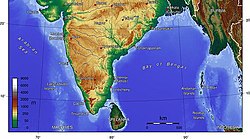



Coastal India is a geo-cultural region in the Indian subcontinent that spans the entire coastline of India. [1]
Contents
- Geography
- Eastern Coastal India
- Western Coastal India
- History
- Culture
- Economy
- Ancient trading routes
- Modern shipping routes
- Channels
- Bay of Bengal channels
- Laccadive Sea channels
- Arabian Sea channels
- Museum
- Gallery
- See also
- References
In 2024, the Indian total coastline was estimated to be 11,098.81 km. [2] Earlier in 1970, the National Hydrographic Office and Survey of India had calculated the coastline to be 7,516 km; as per the then existing techniques and technologies of measurement. As per 2024 data, Gujarat has the longest coastline with 2,340 km. The 2nd longest coastline belongs to Tamil Nadu with 1,068 km; followed by Andhra Pradesh with 1,053 km and West Bengal with 721 km. [2]













